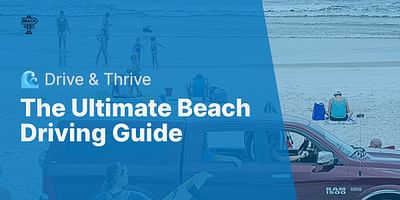Garrison is a fervent enthusiast of beach driving, always seeking to explore the world's coastlines. He holds a profound comprehension of the ins and outs of beach driving regulations, and his zeal for sharing this knowledge with others is second to none. Garrison considers beach driving as a thrilling and distinctive approach to immerse oneself in the grandeur of nature.
Driving on the beach for the first time can be an exhilarating experience, but it's important to be prepared and follow some essential tips to ensure a safe and enjoyable adventure. Here are some tips for first-time beach drivers:
1. Check the regulations: Before hitting the sand, it's crucial to familiarize yourself with the beach driving regulations in the area you plan to visit. Some beaches have specific rules and restrictions, such as speed limits, designated driving areas, and permits. Make sure to research and follow these regulations to avoid any fines or penalties.
2. Use a suitable vehicle: Not all vehicles are suitable for driving on the beach. It's best to use a four-wheel-drive (4WD) or all-wheel-drive (AWD) vehicle with high ground clearance. These types of vehicles provide better traction and stability on sandy terrain. Additionally, consider deflating your tires slightly to increase traction and prevent them from sinking into the sand.
3. Pack the essentials: When heading to the beach, make sure to pack a few essential items. These include a shovel, tow strap, tire pressure gauge, jack, and a portable air compressor. These tools will come in handy if you get stuck or need to adjust your tire pressure. Don't forget to bring a first aid kit, plenty of water, and some snacks too!
4. Scout the area: Before driving onto the beach, take some time to scout the area. Look for any potential hazards such as soft sand, rocks, or deep water. It's also a good idea to observe other beach drivers and see which routes they take. This will give you a better idea of the safest and most accessible paths to follow.
5. Drive at a safe speed: When driving on the beach, it's important to maintain a safe speed. Excessive speed can cause your vehicle to lose traction and become difficult to control. Keep in mind that driving on sand requires more time to accelerate and brake compared to driving on paved roads. Take it slow and enjoy the scenery!
6. Avoid sensitive areas: Many beaches have designated areas that are off-limits to vehicles to protect sensitive ecosystems. Respect these areas and avoid driving on dunes, vegetation, or nesting sites. Stick to designated driving areas and follow any signage or markers indicating restricted zones.
7. Be mindful of tides: Keep an eye on the tide schedule and plan your beach driving accordingly. It's important to avoid driving close to the water's edge, especially during high tide. The soft sand near the water can be unstable and increase the risk of getting stuck or even swept away by the waves.
Remember, beach driving is a privilege, and it's our responsibility to protect the environment and ensure the safety of ourselves and others. By following these tips, you'll be well-prepared for your first beach driving adventure. So, pack your sunscreen, buckle up, and get ready to enjoy the beauty of the coast from behind the wheel!















